 |
| Graffiti of a ship. The date etched beneath the doodle seems to suggest that the drawing was made in the late 18th century. |
Oddly, though we wandered around the cathedral together for something like 30-45 minutes, The Stranger and I never formally introduced ourselves; I have no idea what his name is. Because I can't bear to keep referring to him as The Stranger, I'm going to name him Elvis for the purposes of this tale. This is not a random choice; The Stranger really did look like an "Elvis." He had kind of a rockabilly air about him, with a worn red leather outer jacket, a brightly colored striped sports jacket, and a pair of pointy, red-flowered shoes/boots. He wore a large red/pink plastic flower on his lapel, and a rosary around his neck; his dark blackish hair was combed away from his tanned skin, and I believe he was the origin of a very clean scent that I kept smelling as we toured the building. Also, he had a lovely northern accent, which I love.
Elvis informed me that he was a member of the church, and, indeed, he seemed to know the employees and volunteers that we encountered as we wandered around. I can't imagine that all parishioners are as knowledgeable as he is, though; he said that he was studying history (whether as an enrolled student or just for fun, I don't know), and I assume that much of his knowledge came from this research.
We started off in the eastern portion of the church, where I had been photographing some of the tombs. Both of the ones I had been looking at featured angels sitting next to the head of the deceased; according to Elvis, these showed that the departed individuals were quite important, since the heavenly creatures were waiting to escort the souls straight to Heaven. Another indication of the men's importance was the fact that both had their feet resting on dragons.
One of the tombs had two parts. On the upper half, the carved figure showed the man fully dressed in his finery; on the lower, you could see only skeletal remains. This was meant as a reminder that, underneath it all, everyone is the same--equally susceptible to death and decay.
Also near the east window is St. Hugh's head shrine. St. Hugh is often associated with swans--many of which can be seen around the Lincoln Cathedral (not to mention in the river that runs through town). When his body was being moved from one site of interment to another, St. Hugh's head fell off and, eventually, went missing; hence "head shrine." In fact, the rest of Hugh's relics have also been missing since the Reformation. However, this does not deter the many pilgrims who have come to visit the cathedral since his death in the early 13th century. So many have knelt to pray at his shrine that their toes have noticeably worn down the stone there.
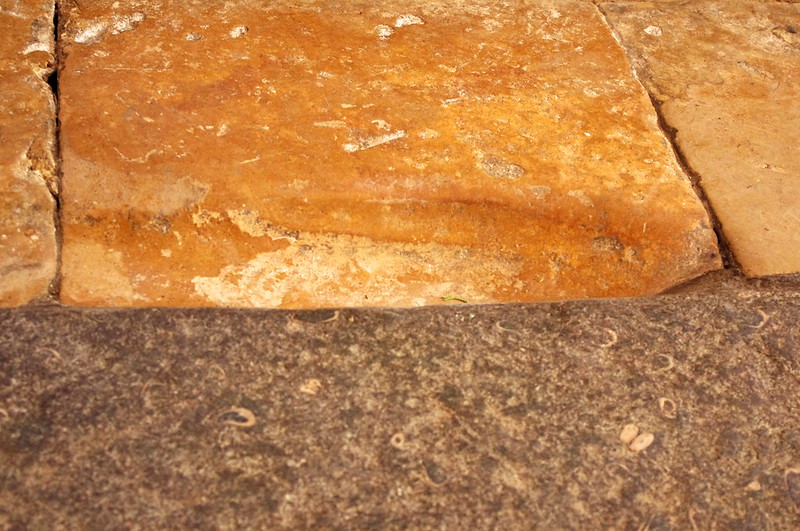 |
| The worn stone looks much more dramatic and impressive in person, I promise. |
Also on the floor are many plaques marking the "tombs" of deceased parishioners. In fact, nobody is buried underneath the church floor, which rests primarily upon solid stone (left, I believe, from previous versions of the church that were later replaced during reconstructions). Instead, the plaques were situated in these places of honor, but the bodies were put nearby in more amenable (and more easily accessible) burial grounds.
 |
| One of my favorite "tombstones." It reminds me of the Baratheon coat of arms in Game of Thrones! |
People who were wealthy enough to have plaques decorated with bronze were given the dubious honor of providing Oliver Cromwell with metal to forge swords; all but one such stone were stripped of their finery in the 17th century. Cromwell used the cathedral to house his troops, and metal-stealing is one of the least destructive things he did in the building. He also routinely rode his horse around the church and chopped off decorations--particularly statues' heads--with his sword. If you look closely, you can see joins where these were later reattached. According to Elvis, there is one statue where the body of a female saint has been given a male head--oops!
If you face north while standing in the east wing and look up instead of down, you will be able to see the Lincoln Imp. As you might imagine, there is a legend associated with the imp. Apparently it was one of a pair that were wreaking havoc in the cathedral before an angel appeared out of a hymnal and commanded them to stop. When they did not, the angel turned the first imp into stone; the other subsequently escaped. Surprisingly, the imp has since become the city's symbol.
On the other side of the east wing is a small chapel decorated by a brightly colored mural depicting Christ, several shepherds, and some sailors.
You don't have to look too closely to notice that there aren't too many ladies on these walls, or to see that the ones who are present aren't looking too lively or attractive. Men, on the other hand, are not only present, but are also quite athletic, handsome, sensuous, and...lacking in clothes. These qualities did not go unobserved by viewers after the mural was unveiled in the Victorian era; nor did the fact that the men in the painting looked an awful lot like "close acquaintances" of the (male) artist (seen here in the circular portrait above the doorway). As a result of this perceived unseemliness, the chapel was closed for many years until prevailing viewpoints became a bit more liberal.
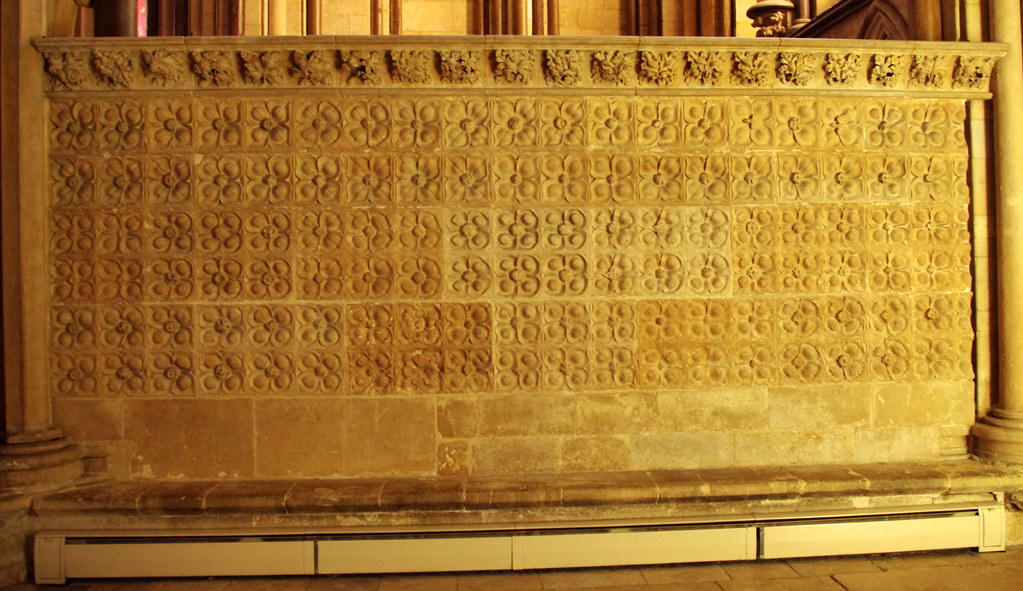 |
| The apprentice wall |
Down the hall from the chapel is something known as the apprentice wall, where apprentices had to prove their skill before they could receive permission to work on more illustrious portions of the building. Each square was worked by a different person, and the variations in style and ability are quite obvious once you know to look for them.
Elvis and I next exited the eastern portion of the cathedral and walked out into the south transept. The doorway in between the two sections is decorated with motifs indicating that the average Joe should stay out in the nave:
Out in the nave, Elvis pointed out the south-facing rose window, known as the Bishop's Eye. At some point in the cathedral's past, the window fell in and shattered into hundreds of pieces. Rather than restore it to its original form, people simply put the pieces in willy-nilly. At first glance it looks no different from the rose window on the other side of the crossing (the Dean's Eye), but upon closer inspection you can see that it is merely a colorful jumble, rather than a series of panes that tell a story.
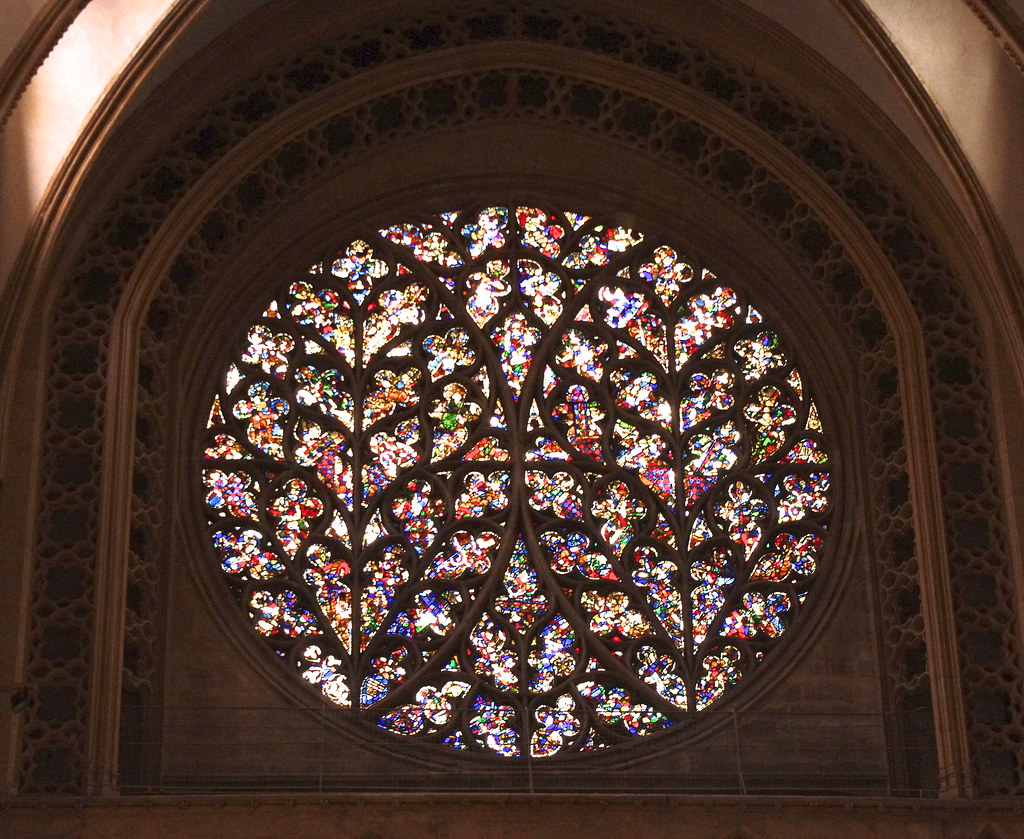 |
| According to Elvis, you can get a good view of the mismatched stained glass if you take the tower tour, which gives you an insider's view of all the high places in the cathedral. |
From the crossing, we walked out into the nave, which features 12 columns--one for each of the apostles. Just as one of the apostles was not like the others, so, too, was one of the columns different from the other 11:
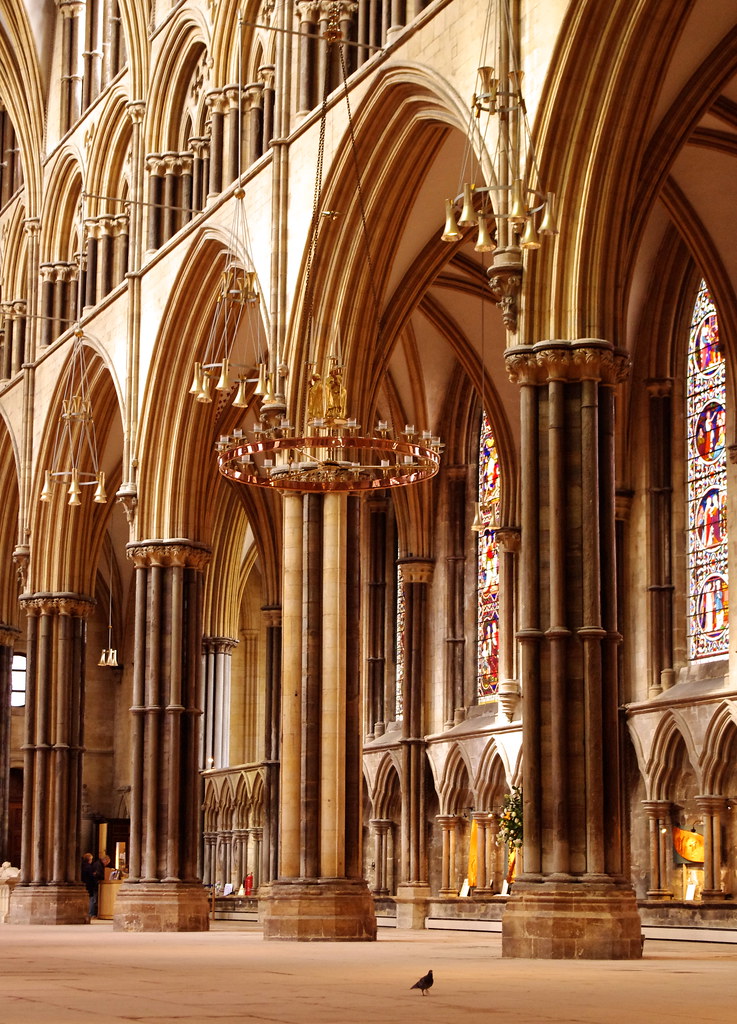 |
| The column in the center--with 2 large posts and lighter-colored stone--is the "Judas column". |
The Judas column, as Elvis called it, is made with subpar materials and in a slightly different style--though, of course, it is just as capable of supporting weight. Interestingly, all 12 current columns stand about 1-2 feet from where the cathedral's original columns stood. The column closest to the crossing has a small trap door at its base; Elvis waited until nobody was looking and pulled the door open to show me the shorn-off bottom of the original plinth. The contemporary columns are in a new location because the cathedral suffered extreme structural damage after an earthquake struck in the late 12th century. This resulted in extensive reconstruction throughout much of the building. However, funds ran out before the final bit--around the entryway--could be finished.
If you look along the "spine" that runs down the center of the ceiling, you can see that the "new" one (closer to you) is offset from the original one (near the far window) by 1-2 feet.
The crossing area also features an ornate choir screen decorated with a variety of objects--flowers, people, even, in one whimsical section, pigs. Here you can see the remnants of the colorful paint that had once been applied throughout the cathedral. I had no idea this type of decoration was ever done in stone churches from this era(s), and I am not sure how widespread the technique was. It has made me wonder about all the other "plain" cathedrals I've ever visited in the past. You can see other colorful remnants elsewhere in the building, as well, though some of them are a bit newer (and brighter) than others:
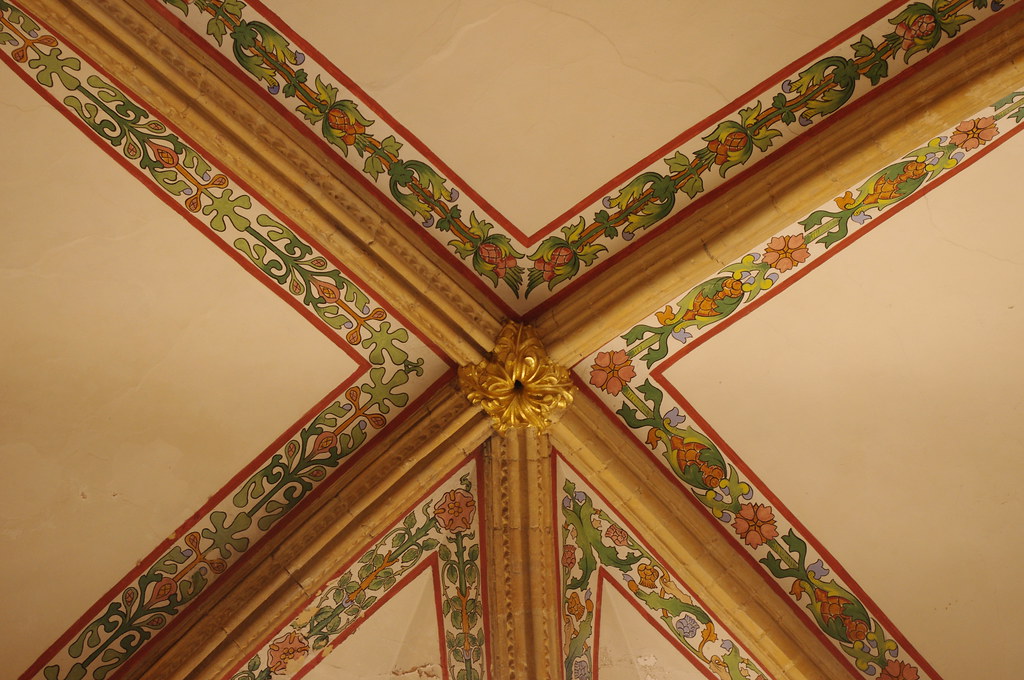 |
| Colorful paintings on the roof of the south transept chapel. |
If you squint, you might just be able to make out the green man being illuminated by the light inside this tubular sculpture of foliage. The greenery is emerging from the green man's mouth, and terminates on the other side of the arch in a dragon.
Elvis and I passed under the arch and made our way into the magnificent St. Hugh's Choir:
Here you can see a number of beautiful, ornate, and interesting objects--the giant organ (no jokes, please), the eagle lectern, the acoustic sweet spot (you can see it in the image above as the grey bit on the floor, running left to right just in front of the table in the center of the room), the misericord (or mercy seat, used to provide a resting spot for tired bums), and the "cathedral seat," which, Elvis told me, makes the cathedral a cathedral; remove the seat and the cathedral is just a fancy church, and put the seat in any old ordinary building and it will become a cathedral. I have no idea if that's true or not, but here's what it looks like:
After we left the choir, we went through the northeast transept into the cloister area and chapter house. Elvis informed me that the chapter house had been used to shoot some scenes in the The Da Vinci Code, which I will have to look out for next time I catch the movie on TV. The area is currently being used as a venue for an art exhibit, and is also a post-christening gathering spot (though personally I think it's a bit chilly for social activities).
The cloister was evidently never actually used as such, but was added on to the cathedral simply because someone thought it sounded like a good idea and would look nice. Parishioners who wish to be buried "in" the cathedral are actually buried in the western portion of the cloister; Elvis informed me very matter-of-factly that he had already booked his spot (an expediency required by the popularity of these graves). Overlooking the cloister is the cathedral library, which houses a variety of old volumes--some of which are chained in place because of concerns about robbery. On the south side of the area is a cart with a mirror on top; look down into the mirror and you can see another imp carved into the ceiling that covers the passageway.
Shortly after we re-entered the cathedral, Elvis and I parted ways so that he could go meet his son at the castle. I scurried off to photograph the odds and ends I hadn't managed to capture during my first time around the building.
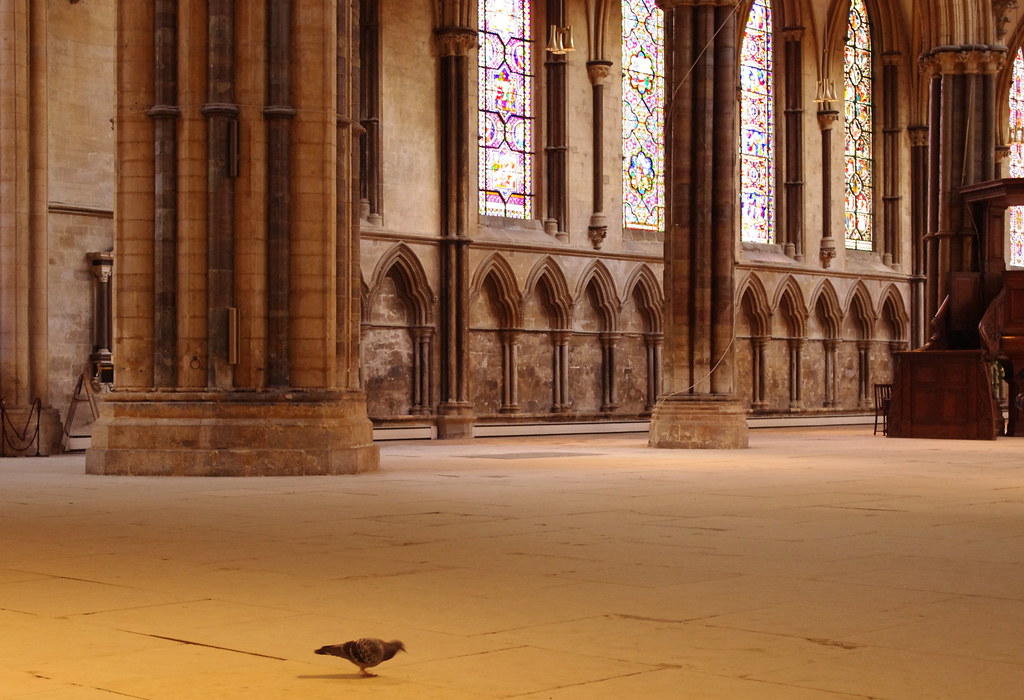 |
| Elvis informed me that this pigeon has been flying around the church for a couple of weeks, and that he (Elvis, not the pigeon) has been feeding it in an attempt to lure it in for a removal. |
I also stepped outside for some perspective images of the cathedral:
 |
| The cathedral in its medieval, cobbled milieu. |
By this time it was quite late in the afternoon, and I was more than ready to find a cafe where I could have a hot cup of tea and a quick bite (more on which later!). As much as I was anticipating this lovely meal, however, I was a bit sad to bid farewell to the cathedral--and, more importantly, to the very knowledgeable Elvis, who made my afternoon much more interesting and rewarding than it would have been if I had dismissed him and wandered around the building on my own. While I don't think I'll make a habit of hanging out and chatting with people I've never before encountered, my experience at Lincoln Cathedral has taught me that, on some occasions at least, good things do happen when you meet strangers.
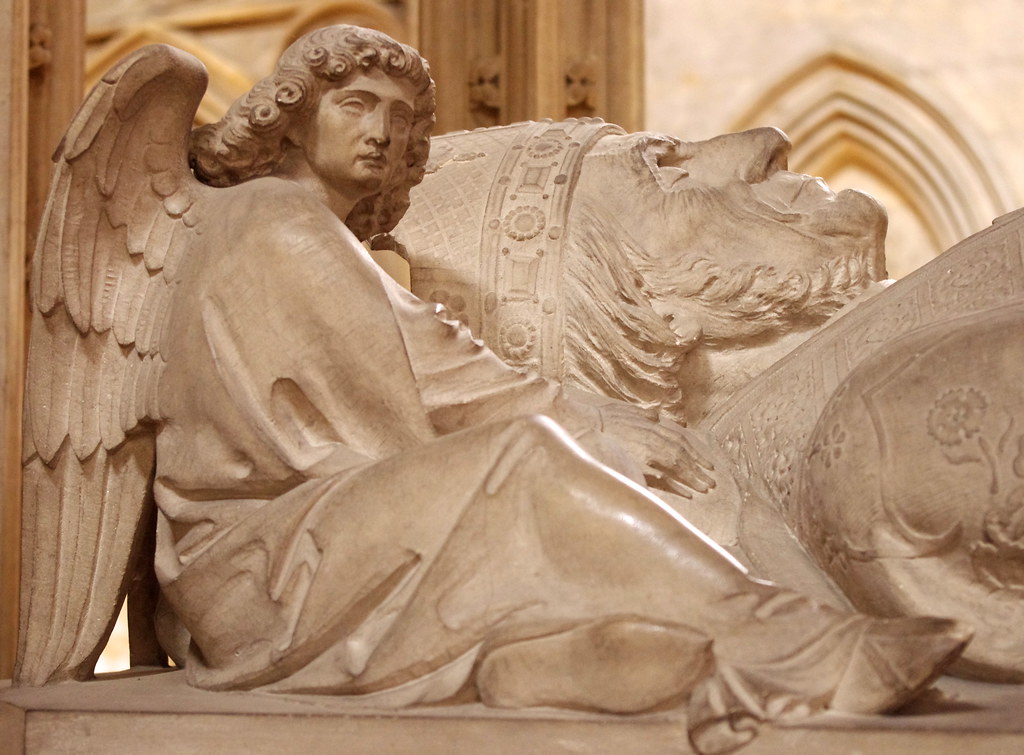


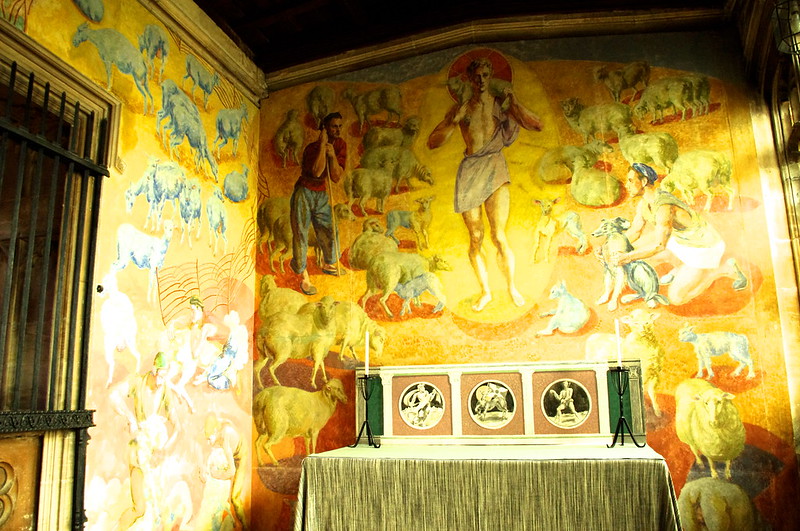

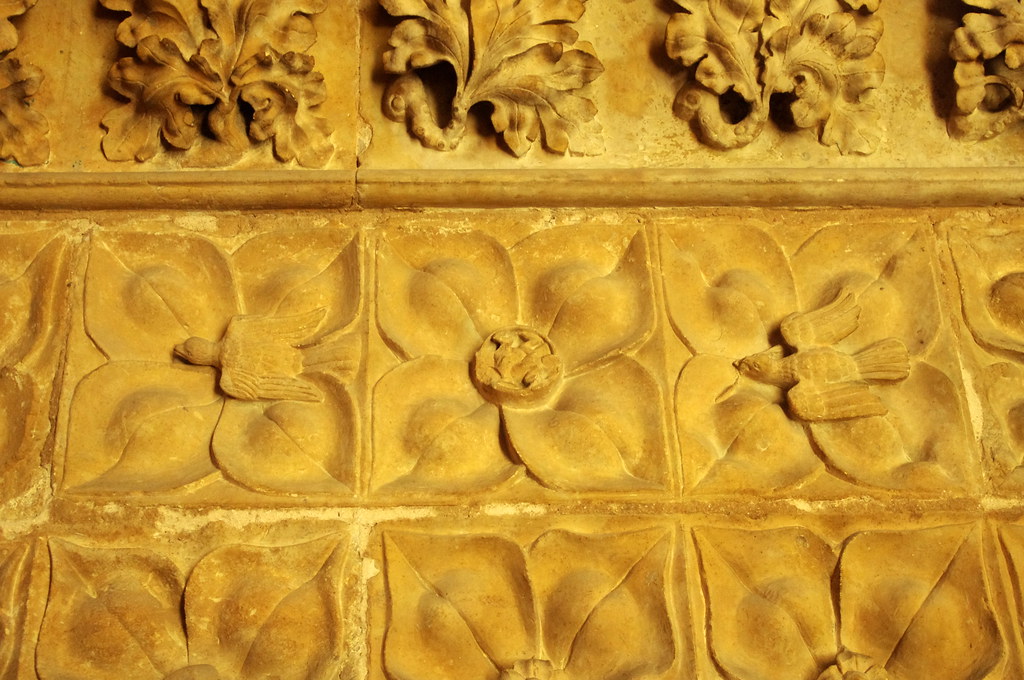



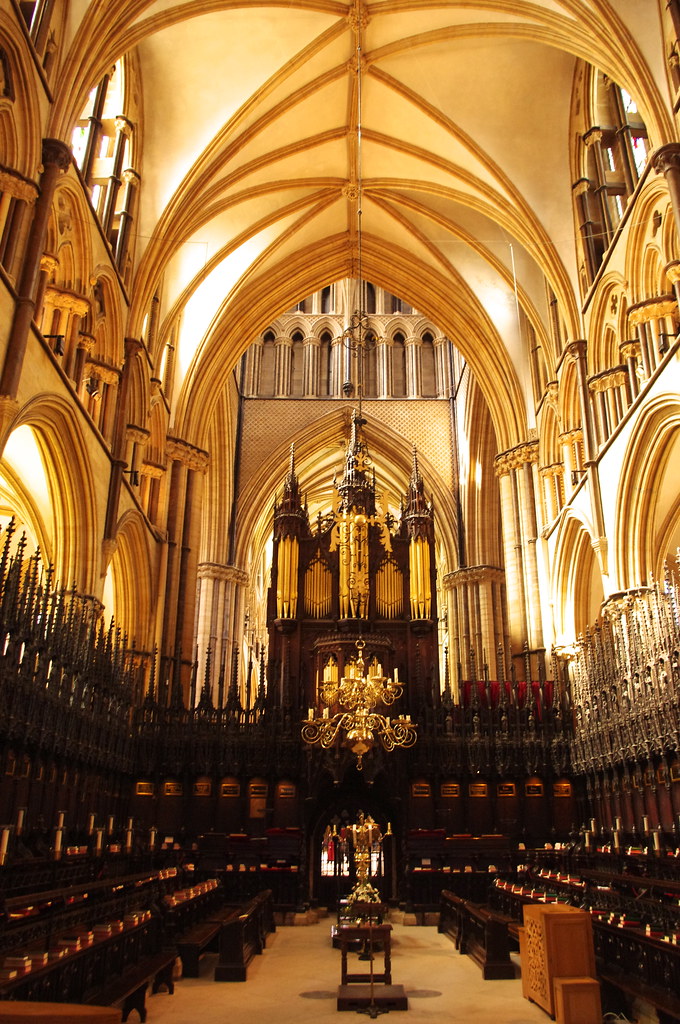
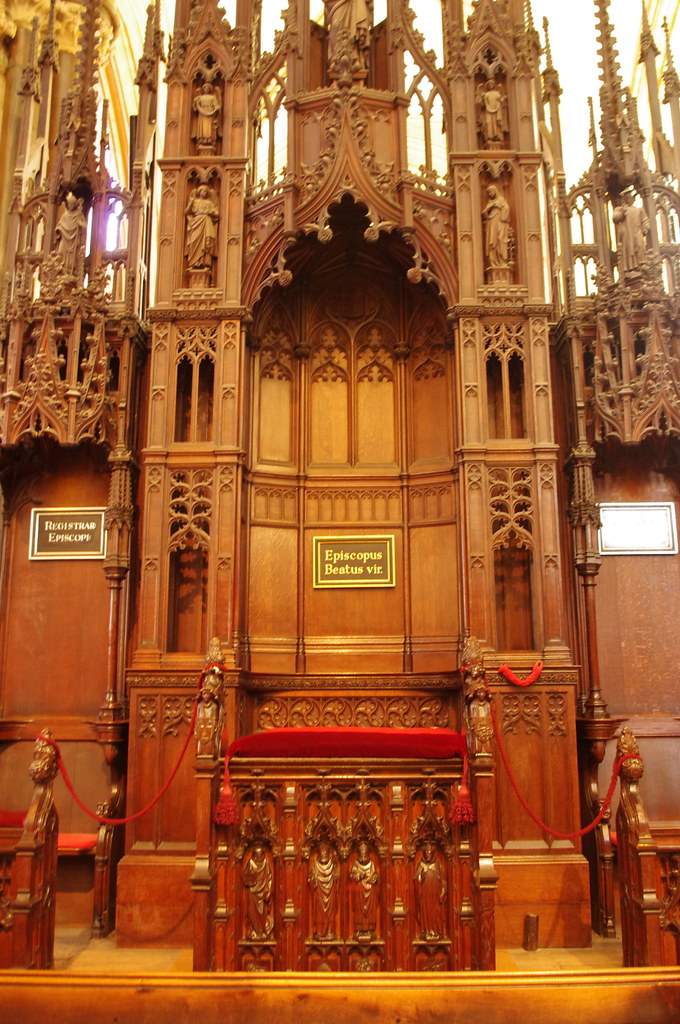


No comments:
Post a Comment